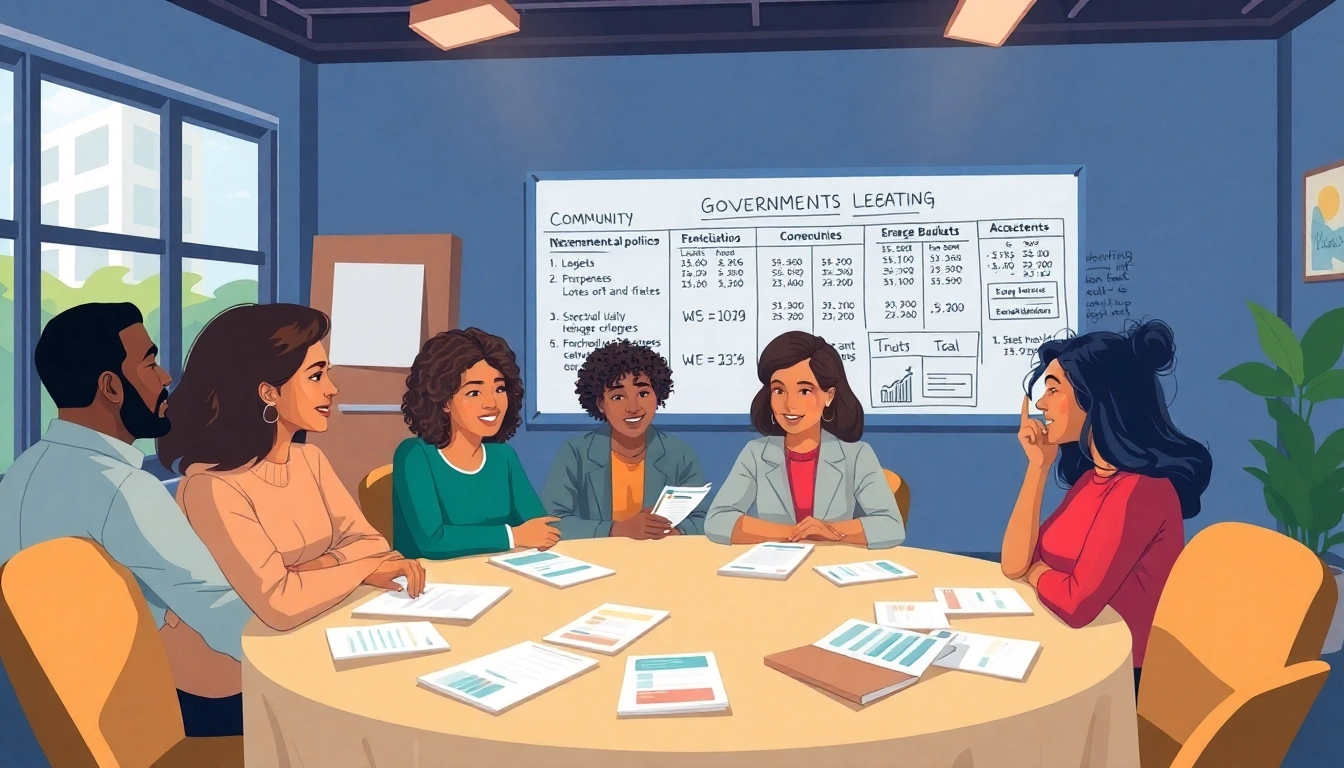
The Basics of Government
Government is an essential pillar of any organized community, representing the system or group of people governing a state or community. At its core, government encompasses a structure of authority that has the mandate to carry out the will of the people, enforce laws, and implement public policy. Understanding the mechanisms of government is vital for citizens who wish to engage effectively with their communities and navigate the complexities of modern governance. Government provides a framework for societal organization, influencing every aspect of our lives from the services we receive to the rules we abide by.
What is Government?
At its most fundamental level, government is a system through which communities and states regulate their affairs and maintain order. It consists of various branches that work together to create and enforce laws, ensuring the functioning of societal mechanisms. The broad definition of government includes several components: legislative bodies that create laws, executive authorities that implement said laws, and judicial systems that interpret them. This interconnected system is designed to reflect the will of the people, providing a foundation for civil society.
Different Types of Government
The classification of governments can vary depending on their underlying principles, structure, and the means by which authority is asserted. Understanding these different types can help citizens recognize how their own governments operate. Key types include:
- Democracy: A government system where power lies with the electorate, who make decisions through voting. Examples include direct democracies and representative democracies.
- Monarchy: A form of government where a royal family holds significant power. Monarchies can be absolute—where the monarch has almost complete control—or constitutional, wherein the monarch operates within a framework of laws.
- Authoritarianism: This type of governance centralizes power in a ruling party or individual, often at the expense of personal freedoms and civil liberties.
- Oligarchy: A governance model where a small group, typically wealthy or influential individuals, exert control over political decisions.
Core Functions of Government
The functions of government go beyond mere lawmaking—they are integral to societal stability and development. The primary functions include:
- Legislation: Crafting laws intended to maintain order, protect citizens, and promote societal welfare.
- Administration: Implementing and overseeing the execution of laws and policies, ensuring they are followed effectively and efficiently.
- Judicial Oversight: Interpreting laws and adjudicating disputes to uphold legal principles.
- Public Services: Providing essential services such as education, healthcare, transportation, and public safety to enhance quality of life.
The Structure of Government
The structure of government is fundamental to understanding how power operates within any state. Typically, this structure comprises three main branches: the legislative, the executive, and the judiciary. Each branch functions independently to check and balance the power held by the others, forming a governmental system that aims to prevent the abuse of power.
Branches of Government Explained
The division of government into branches is a crucial feature designed to ensure accountability and transparency:
- Legislative Branch: Responsible for creating laws, the legislative branch is composed of elected officials representing the citizens. In the United States, this consists of Congress, divided into the Senate and the House of Representatives.
- Executive Branch: The executive branch is led by the President (or equivalent in other nations) and is tasked with enforcing laws and overseeing the federal administration. This branch also includes various administrative agencies that carry out the day-to-day responsibilities of governance.
- Judicial Branch: The judiciary interprets laws and ensures justice is administered fairly. Courts at various levels, including the Supreme Court, play significant roles in reviewing laws and cases, protecting citizens’ rights against governmental abuses.
The Role of Legislatures
Legislatures are critical in shaping public policy and national direction. Comprised of elected representatives, they are tasked with debating proposed laws, amending existing laws, and appropriating government funds. The legislative process often involves several stages, including:
- Introduction of a bill.
- Committee review and amendment.
- Debate in the full chamber.
- Voting and potential passage to the other chamber (if bicameral).
A functioning legislature thus serves as the voice of the people, reflecting societal values and priorities in its decisions.
Judiciary and Government Oversight
The judiciary plays a vital role in maintaining a balance of power among government branches. Through judicial review, courts can challenge and invalidate laws or actions deemed unconstitutional. This oversight fosters accountability and protects individual rights, ensuring that laws are widely applicable and just. The judiciary’s independence from the other branches is critical in preventing any single branch from yielding unchecked power.
Government Policies and Community Influence
Government policies significantly influence the lives of citizens, shaping community interactions and availability of resources. Understanding these policies is crucial for active citizenship and community engagement.
How Policies Affect Daily Life
Government policies can touch every aspect of daily life, including:
- Economic Policies: Regulations governing taxation, spending, and employment can affect job availability and economic stability.
- Social Services: Policies on healthcare, education, and welfare can impact individual opportunities and societal progression.
- Environmental Regulations: Policies aimed at protecting natural resources can influence local economies and health.
- Public Safety: Law enforcement and emergency services policies enhance community safety and security.
Government Programs for Communities
Government programs designed to uplift communities often include initiatives aimed at social welfare, economic development, and public health. Examples of such programs can include:
- Community Development Block Grants (CDBG): These federal funds support housing and economic development projects in low-income areas.
- Public Health Initiatives: Programs addressing community health concerns, including preventive healthcare, vaccination drives, and awareness campaigns.
- Job Training Programs: Initiatives that assist individuals in acquiring new skills to improve employability in the competitive job market.
Engaging with Local Government
Local governance is often where citizens can have the most direct influence. Participation in local government can include:
- Attending town hall meetings to voice concerns and propose ideas.
- Volunteer work for local non-profits and community organizations.
- Engaging in local elections to impact leadership and policy decisions.
Building a strong relationship with local government fosters community unity and gives citizens a voice in the governance process.
Current Government Trends
As society evolves, governments face modern challenges that necessitate adaptation and reform. Recognizing these trends is vital for understanding how governmental functions might change in the future.
Modern Challenges in Governance
Several contemporary challenges confront governments today, including:
- Political Polarization: Increasing divisions among political factions can lead to gridlock and diminish collaborative governance.
- Economic Inequality: Rising disparities in wealth can undermine social cohesion and public health.
- Climate Change: Environmental issues call for immediate government responses that balance economic growth with sustainability.
- Public Trust: A decline in trust towards governmental institutions is a growing concern, necessitating transparency and accountability efforts.
Technological Advances in Government
Technological innovations have transformed how government operates, providing new tools for efficiency and transparency. Key advancements include:
- e-Government: The use of online platforms to provide services, submit forms, and engage with citizens efficiently.
- Data Analytics: Governments leverage data to inform policy decisions, improving service delivery and resource allocation.
- Artificial Intelligence: AI systems assist in processing vast amounts of information and enhancing public service interactions through chatbots and virtual assistants.
The Future of Government Engagement
The future holds promising avenues for enhancing government-citizen engagement. As technology advances, citizens expect greater interaction with their governments. Future trends may include:
- Increased Transparency: Greater access to government data can foster accountability and inform citizen activism.
- Crowdsourcing Solutions: Governments may increasingly crowdsource ideas and solutions to public problems, enhancing community participation.
- Responsive Governance: The use of technology will support governments in adapting rapidly to changing citizen needs and global issues.
Participating in Your Government
Civic engagement is the heartbeat of democracy. Active participation in government processes is essential for promoting representative governance and ensuring that citizens’ voices are heard.
Voting and Civic Responsibility
Voting remains one of the most powerful tools citizens possess in influencing government. Civic responsibility extends beyond voting and encompasses:
- Being informed about candidates and policy issues.
- Engaging in discussions about community needs and government performance.
- Encouraging others to participate in the electoral process.
How to Get Involved Locally
Local engagement is crucial for fostering a sense of community ownership. Options for local involvement can include:
- Joining local boards or committees that influence public policy.
- Participating in community organizing events aimed at addressing local concerns.
- Collaborating with non-governmental organizations to enhance community development.
Advocacy and Policy Change
Understanding and participating in advocacy for policy change can amplify voices of the community. Effective advocacy involves:
- Researching issues to inform oneself and others.
- Building coalitions with like-minded individuals and organizations.
- Leveraging social media to raise awareness and mobilize support.
Ultimately, civic engagement leads to a more responsive government that acts in the best interest of the populace, allowing for significant collaborative change.




